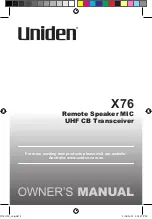
1.
SAFETY
1.1. GENERAL
The ventilation should not be impeded by covering the ventilation openings with items, such as newspapers, table cloths,
•
curtains, etc.
No naked flame sources, such as lighted candles, should be placed on the apparatus.
•
It shall not be exposed to dripping or splashing and no objects filled with liquids, such as vases, shall be placed on the
•
apparatus.
Do not place the product in closed bookcases or racks without proper ventilation.
•
Where the mains plug or an appliance coupler is used as the disconnect device, the disconnect device shall remain
•
readily operable.
1.2. ELECTRICAL SAFETY
WARNING!
It is the user’s responsibility to read, understand and comply with the following electrical instructions:
You must ensure the risk of electric shock is minimised by the installation of appropriate safety devices.
An RCCB (Residual Current Circuit Breaker) should be incorporated in the main distribution board. We also recommend that an
RCD (Residual Current Device) is used with all electrical products, particularly portable equipment which is plugged into an
electrical supply not protected by an RCCB.
You must
also read and understand the following instructions concerning electrical safety.
1.2.1.
The Electricity At Work Act 1989
requires all portable electrical appliances, if used on business premises, to be tested
by a qualified electrician, using a Portable Appliance Tester (PAT), at least once a year.
1.2.2.
The Health & Safety at Work Act 1974
makes owners of electrical appliances responsible for the safe condition of the
appliance and the safety of the appliance operator.
If in any doubt about electrical safety, contact a qualified
electrician.
1.2.3.
You must ensure that you:
Inspect the plug, cable and connector for wear and damage to ensure items are safe before connecting to the mains
power supply.
If worn or damaged
DO NOT
use.
Important: Check that the voltage marked on the radio is the same as the power supply to be used.
DO NOT
pull the plug from the mains socket by the lead.
DO NOT
get the radio wet, or use in wet, damp conditions (for indoor use only).
1.2.4. Ensure that the insulation on all cables and on the appliance is safe before connecting it to the power supply. See 1.2.1.
and 1.2.2. and use a Portable Appliance Tester.
1.2.5. Ensure that cables are always protected against short circuit and overload.
1.2.6.
DO NOT
use worn or damaged cables, plugs or connectors.
Immediately have any faulty item repaired or replaced by a qualified
electrician.
When a BS1363/A UK 3 pin plug is damaged, cut the cable just above the plug
and dispose of the plug safely.
Fit a new plug according to the following instructions (UK only).
a)
Connect the GREEN/YELLOW earth wire to the earth terminal ‘E’.
b)
Connect the BROWN live wire to the live terminal ‘L’.
c)
Connect the BLUE neutral wire to the neutral terminal ‘N’.
d)
After wiring, check that there are no bare wires, that all wires have been
correctly connected, that the cable outer insulation extends beyond the
cable restraint and that the restraint is tight.
Double insulated products, which are always marked with this symbol ,
are fitted with live (brown) and neutral (blue) wires only. To rewire,
connect the wires as indicated right.
DO NOT
connect either wire to the earth terminal.
FUSE RATING
3 AMP
Blue
Neutral
Wire
Yellow & Green
Earth Wire
Cable
Restraint
Brown
Live
Wire
Warning: to reduce the risk of
electric shock,
DO NOT
remove
cover (or back). No user serviceable
parts inside, refer servicing to
qualified
service
personnel.
The lightning flash with arrow-
head symbol, within an equilateral
triangle, is intended to alert
the user to the presence of
un-insulated “dangerous voltage”
within The product’s enclosure that
may be of sufficient magnitude to
constitute a risk of electric shock.
The exclamation point within
an equilateral triangle is
intended to alert the user to
presence of important operating
and maintenance (servicing)
instructions in the literature
accompanying the appliance.
CR01 Issue No: 1 - 24/06/09























